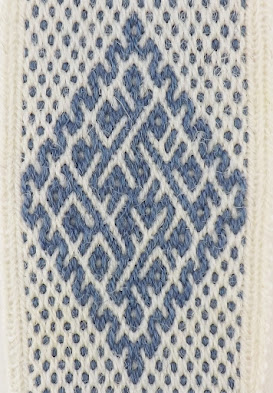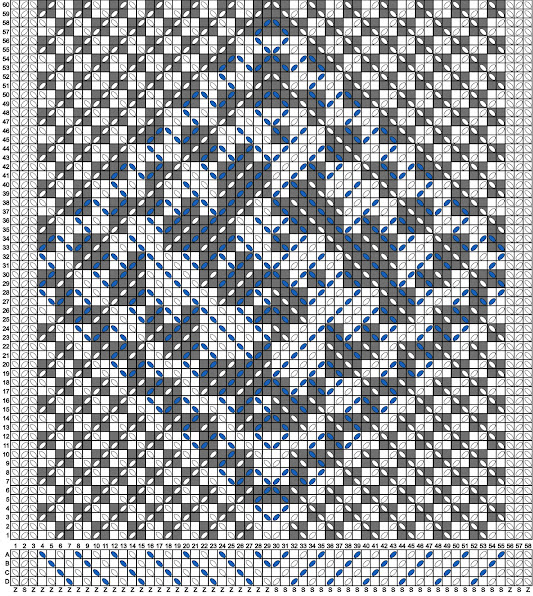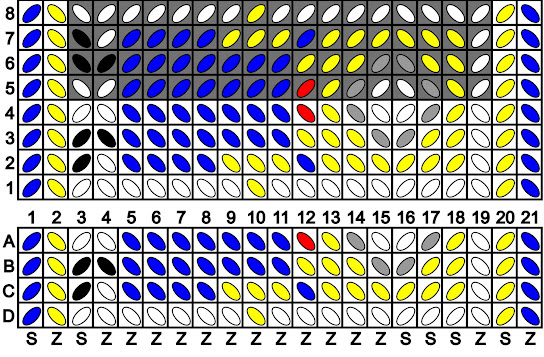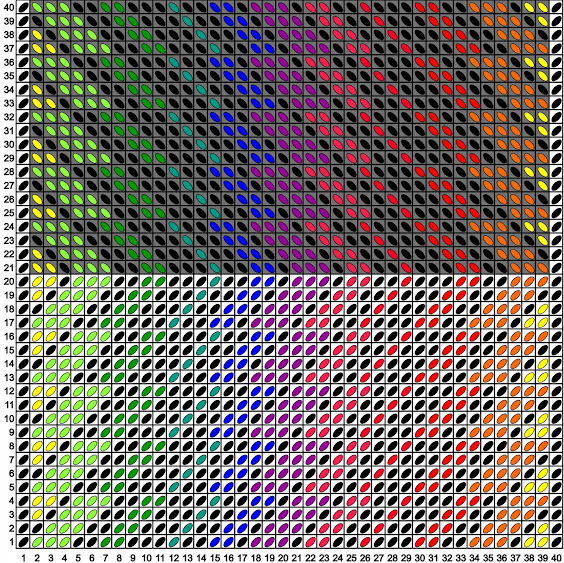Translate
Thursday 29 December 2022
Tablet Weaving Draft Designer Updates!
Monday 21 November 2022
Fleurs-de-Lis
This draft is from one of the two bands I designed based on V&A 838-1894 for my book Tablet Weaving in Theory and Practice: Golden Diagonals. You can find a further eighteen drafts that that use the same threading diagram in the section on V&A 838-1894 in the book, as well as eighteen for its companion band. Golden Diagonals is an exploration of 11th century to 14th century gold brocaded bands (known as orphreys) from certain types of vestments. There a total of 15 bands in the book, based on 8 extant objects: the chasuble of St. Vitalis, the chasuble of St. Wolfgang, the chasuble of St. Heinrich, fragments of a chasuble orphrey cross, V&A 1256-1864, V&A 838-1894, the Hildesheim cope, and the orphrey of abbot John Dygon. I've translated many of the motifs into other tablet woven structures: warp-twining, simple double-face, warp-floats, threaded-in, Icelandic vacant-hole, and two-hole weaving, as well as including two bands in the brocade of the originals.
I wove the sample for this band (Band 11 of the book) in King Cole Merino Blend 4-ply wool yarn in the colours mustard yellow, white, and blackcurrant purple, with additional blackcurrant purple yarn as my weft.
This orphrey fragment is held by the Victoria & Albert Museum, UK, but is no longer associated with a specific vestment. Unfortunately, this is not unusual, due to the re-tailoring and conservation process that many vestments have been through and the practice of retaining the ornaments when the accompanying garment itself is beyond use. A second fragment (inventory number: MT 35053) of this band survives and is held by the Musée des Tissus, France. They have been dated to 1100-1299 by the V&A or, more specifically, the 13th century by the Musée des Tissus. It is believed that they were woven in Sicily, Italy[1], although the V&A identifies its fragment as German, which may be more of an indication of where it was used as an orphrey as part of a vestment.
The Musée des Tissus fragment is 113mm wide and 510mm long; the V&A fragment is a little longer, as the final quarter of the motif section at the bottom edge of the Musée des Tissus piece is cut off. The original orphrey was woven using 160 square tablets, threaded in all four holes with a fine 2-ply silk thread, now beige-coloured with hints of rose[1] and a rose silk main weft. The tablets were set up in an alternating threading and turned continuously together in the same direction. There is no evidence[2] that their turning direction was reversed during weaving, but this may not be representative of the original band as a whole.
The V&A fragment has 6 lozenges containing either 4 fleurs-de-lis or a spiralling motif, against either a green or beige background, decorated with angular vines with either flowers or buds. The background of each section is filled with small brocaded diamonds. Each motif section is 140mm long[2] and is formed by brocade threads in beige, green, brown, red, and purple silks, with spun gold and silver threads with cream silk cores, used doubled. The back of the band shows that the brocade threads were used economically, passing along the back when not needed. It would have been complex to weave, as multiple different colours of brocade weft were in use at a time and they each appear to have been wound on enough shuttles to allow them to be used only in localised areas, without them needing to pass across the space between motifs.
I adapted this band (Band 11 of Golden Diagonals) from the motifs on the V&A fragment of the orphrey, alongside it sister band (Band 10). They both have the same motifs, but for 67 tablets (Band 10) and 34 tablets (Band 11). The orphrey fragment has a total of three spiralling motifs, so I separated them into centres and frames, then recombined them to give a total of nine motifs. I then designed another three frames which give us another nine motifs, when combined with the centres. I had a lot of fun with these two bands, especially the part where I was translating the motifs for half as many pattern tablets.
You can download the TDD file for this draft by clicking here.
You can download the text version of this draft by clicking here.
References
[1] Spies, N. (2000). Ecclesiastical Pomp and Aristocratic Circumstance: A Thousand Years Of Brocaded Tabletwoven Bands, Arelate Studio.
Medieval Errors
This draft is from one of the two bands I designed based on the Hildesheim cope (held by the Victoria & Albert Museum, UK) for my book Tablet Weaving in Theory and Practice: Golden Diagonals. You can find a further six that use the same threading diagram in the section on the Hildesheim cope in the book. Golden Diagonals is an exploration of 11th century to 14th century gold brocaded bands (known as orphreys) from certain types of vestments. There a total of 15 bands in the book, based on 8 extant objects: the chasuble of St. Vitalis, the chasuble of St. Wolfgang, the chasuble of St. Heinrich, fragments of a chasuble orphrey cross, V&A 1256-1864, V&A 838-1894, the Hildesheim cope, and the orphrey of abbot John Dygon. I've translated many of the motifs into other tablet woven structures: warp-twining, simple double-face, warp-floats, threaded-in, Icelandic vacant-hole, and two-hole weaving, as well as including two bands in the brocade of the originals.
The Hildesheim cope (V&A inventory number: 17-1873), would have been worn by Christian priests during processions as a cape-like garment over other vestments. It is a masterpiece of German brick-stitch embroidery storytelling, depicting the martyring of 29 different saints in bright, colourful silks. Each of the saints and their tormentors are housed in a circle which overlaps its neighbours, forming curved-edged hexagons, and wear clothing decorated in geometric designs. While the congregation in early 14th-century Germany, where the cope was made, may not all have been literate, they would have recognised the symbolism in each of the hexagons and been able to identify each saint when they came into view as the priest moved and the folds of the garment shifted.
The two tablet woven orphreys on the cope hold pride of place, where they would have been most noticeable during use. It is believed that the bands (possibly from Köln, Germany[1]) are not original to the vestment and were added during later reshaping work. The band I describe as the "vertical orphrey" would have hung down the priest's spine, on the centre-back of the garment and the band I describe as the "horizontal orphrey" would have been worn as two vertical strips down the priest's front. The vertical orphrey is the wider of the two bands and is decorated with large lozenges framing a single repeated spiralling motif, brocaded alternately in blue and two other colours of silk (which are unfortunately now badly faded).
You can read more about the cope itself and its horizontal and vertical orphreys in Tablet Weaving in Theory and Practice: Golden Diagonals. The motifs of two smaller brocaded tablet woven bands that form the edgings of the vertical orphrey and the vestigial hood are described in my book Tablet Weaving in Theory and Practice: Vacant-Hole Pinwheels Revised Edition.
I adapted this band (Band 13 of Golden Diagonals) from the repeating motif on the vertical orphrey of the Hildesheim cope, with two additional motifs inspired by some of the weaving errors on the orphrey. Of the 11 motifs currently visible on the orphrey (there may be a 12th hidden behind the vestigial hood), 9 include at least one error, although their commonalities suggest that they were intended to be identical. Such errors are reasonably common in such bands, especially where the weave structure is complex and uses a large number of tablets, dissuading the weaver from undoing their work to make corrections[2][3].
You can download the TDD file for this draft by clicking here.
You can download the text version of this draft by clicking here.
References
[1] Epe, E. et al. (1991). Schatzkammer auf Zeit. Die Sammlungen des Bischofs Eduard Jakob Wedekin, 1769-1870, Diözesan-Museum Hildesheim. (pp. 168-9)
[2] Hansen, E. (1990). Tablet Weaving: History, Techniques, Colours, Patterns, Hovedland Publishers.
[3] Ræder Knudsen, L. (2004). Written Patterns in Early Tablet Weaving, In: Priceless Invention of Humanity: Textiles. North European Symposium for Archaeological Textiles VIII. (pp. 121-128)
As with all of the free patterns/drafts on this site, you are welcome to weave them, sell bands woven using them, and use them to teach other weavers, just as long as you state where you found them.
Sunday 13 November 2022
Further Book News
We're close, we're very close!
Over the last few weeks, the book made it through copy-editing, ("You may keep 33% of the commas in this sentence" and other such mean things were said), the image samples came and I edited the rest of the photos, I finalised the text, and tidied up the reference list. Then, last night... LAST NIGHT... I uploaded the file to my publisher and set them going on the proof copies! I may be more than a little excited that it's almost time to share it with you. I'm expecting the proof copies on or before 25/11/2022, so expect the publishing date (provided that the proofs are ok) to be either late November or early December.
In the meantime, I'll be working on the two freebie drafts related to the book that I'm releasing here and videos about the book and each of the 16 bands featured in it.
Sunday 30 October 2022
New Book Update
The new book is coming along and is almost finished! It's been through the copy editing stage (I have a few things to tidy up that got flagged and are still outstanding) and the publisher has the image samples to print, which should hopefully arrive by the end of the week. Once I have them back, I'll edit the remaining photos and get them in place in the book and upload it for printing! It's looking good for a final release date at the end of November. As usual it'll be available in hardcover, softcover and pdf. In the days leading up to release day I'll be adding two free drafts to the blog that tie in with the bands in the book.
I'm looking forward to seeing what people weave from it!
Wednesday 31 August 2022
Research Woes and Further Book News
Friday 12 August 2022
Blurb Hardcopy Sale
This weekend my publisher, Blurb.com, are running a 20% off sale event this weekend (15th August-17th August, ending at 11.59pm local time). You can find the links to the sale pages for all my books here and in the right bar to the right. Just use the code BOOKSMARTS at checkout to get the discount on all hardcopies.
Monday 11 July 2022
Book News!
Since January this year, I've been working on my next book project. I'm really excited to share it with you and it should hopefully be ready to publish towards the end of September.
It's an exploration of medieval tablet woven orphreys (gold bands found on ecclesiastical vestments), looking at 8 different extant objects, with plenty of background notes on each of them. I've translated many of the motifs into other tablet woven structures, including: warp-twining, simple double-face, warp-floats, threaded-in, Icelandic vacant-hole, and two-hole weaving, as well as two bands brocaded like the originals. I'm also including information about weaving in each of the structures and instructions on reducing the number of tablets if desired.
There will be 14 bands, using numbers of tablets ranging from 18 to 80, for you to weave and a total of 78 individual drafts to mix and match. They are a variety of different difficulty levels, making the book accessible for beginners and more experienced weavers alike.
I'm looking forward to seeing the bands people weave from it!
Thursday 5 May 2022
Minions
I originally designed and wove this draft back in 2015 and shared in the Baelfyr (the Insulae Draconis SCA group newsletter), but it never made it as far as the blog. While the draft for this band is my own invention, the subject, Minions, belongs solely and completely to Universal Studios.
It was an interesting one to weave, as I was swapping out threads on the fly when they weren't giving me the effect I wanted. I cut the offending thread 5cm away from the edge of the band, pulled it out of its tablet, cut a new piece to length, tied it onto the back of the loom, threaded it through the tablet, then tied it on to the cut end of the old thread. The result was somewhat messy, but each thread swap got me closer to what I was hoping for. Unfortunately, I don't have much of the finished band, as it went to live with a friend. If I was to weave it again, I would use a white weft rather than a blue one, to avoid the little blue dots on the background between the Minions.
You can download the .tdd file for this draft by clicking here
You can download the text version for this draft by clicking here
To form the black eye dots, thread a needle with black yarn, the same as the one used in the warp, held doubled and make small running stitches across the diamond goggle section, carrying the thread behind the band between stitches.
As with all of the free drafts/patterns on this site, you are welcome to weave them, sell bands woven using them, and use them to teach other weavers, just as long as you state where you found them.
Thursday 17 February 2022
A Study in Stripes
I designed and wove this band to play around with diagonal lines of different widths way back in 2016, when I first started trying to write about tablet weaving in earnest. The draft for it has been requested over on Instagram (you can find me there as @tabletweaving), so I'm taking the time to give it a proper write up. As it's one of my experimental samples, there are 4 different turning sequences to try, all of which are twist neutral for the pattern tablets. Bonus points if you can identify the book that the name refers to!
The definite star of this draft is the tubular spectrum by Lunatic Fringe Yarns. I used their black 10/2 mercerised cotton alongside (in the same order as in the draft, from left to right) #10 yellow, #10 green yellow, #10 green, #10 blue green, #10 blue, #10 purple blue, #10 purple, #10 red purple, #10 red and #10 yellow red, all also in 10/2 mercerised cotton. Mercerised cotton is really smooth and strong and a dream to tablet weave with, so I would recommend this yarn to both beginners and more experienced weavers alike. I've done my best to recreate the colours in the drafts, but I haven't quite been able to do justice to the vibrancy of the original.
The threading diagram for this band is as follows:
You can download the text version of the threading diagram by clicking here.
The text version of the first variation is a follows:
turn all tablets forwards for 4 picks, then turn tablets 1 and 40 forwards and the remaining tablets backwards for 4 picks.
You can download the TDD file here.
The text version of the second variation is a follows:
turn all tablets forwards for 20 picks, then turn tablets 1 and 40 forwards and the remaining tablets backwards for 20 picks.
You can download the TDD file here.
The text version of the third variation is a follows:
turn all tablets forwards for 4 picks, then turn tablets 1 and 40 forwards and the remaining tablets backwards for 2 picks, then turn all tablets forwards for 2 picks, then turn tablets 1 and 40 forwards and the remaining tablets backwards for 4 picks.
You can download the TDD file here.
The text version of the fourth variation is a follows:
turn all tablets forwards for 8 picks, then turn tablets 1 and 40 forwards and the remaining tablets backwards for 8 picks.
You can download the TDD file here.
As with all of the free drafts/patterns on this site, you are welcome to weave them, sell bands woven using them, and use them to teach other weavers, just as long as you state where you found them.Monday 3 January 2022
New Year, New Tablet Weaving Draft Designer Features!
James has done some work on TDD over the Christmas and New Year period, squashing a few bugs and adding four new features.
At the bottom of the Controls section of the Control Panel, you will find a box labelled Lock Draft. If you click on it, it will prevent changes from being made in the draft. Click on it again to unlock the draft again. I'll be using this when I'm weaving from TDD and I don't want stray clicks altering the draft.
In the Display section, there's a box you can click to change the labelling of your tablets from clockwise to anti-clockwise. I always work with clockwise labelled tablets, but I know that some of you prefer it the other way round, so this will hopefully make TDD more useful to you. If you do change your labels in the draft, the change will also be reflected in its text description.
Also in the Display section, you will now find a button called Show Turning Diagram you can click to hide the turning diagram, so you'll be able to export a picture file of just the threading diagram if you want to. Handy for if you're ever working with a number of drafts that all use the same threading diagram, but different turning diagrams and you want to save a bit of space on the page by including the threading diagram separately.
In the Resets section, there is now a button you can press to change the Palette back to its default colours, without otherwise altering the draft. This is going to come in pretty handy when I'm working on a new design and I'm trying out combinations of colours for it.


.jpg)




.jpeg)






